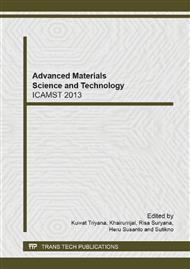p.578
p.582
p.586
p.591
p.596
p.600
p.605
p.609
p.613
The Phenomenon of Pitting Corrosion Attack on the Milled Aluminium Alloy Al 2618 Plate during Surface Preparation through Sulphuric Acid Anodising
Abstract:
This study purposed to investigate corrosion characteristic on aluminium alloy by considering parameters that involved metal preparation, different surface treatment, and alloy types. Through series of the salt spray test, the rolled aluminium sheet revealed higher resistance to surface corrosion rather than milled aluminium plate. However trace elements, as reinforced filler in the metal alloy, may contribute to possible pitting corrosion. By employing sulphuric acid anodising, it revealed higher probability of pitting corrosion to attack the milled aluminium plate surface compared to rolled aluminium sheet. The surface pitting corrosion on the anodised aluminium alloy Al 2618 plate was observed through enlargement of pitting diameter and additional new pitting holes during 500 hours corrosion test. The corrosion propagation grew sharply during 500 hours test and it increased slowly after 750 hours. This study did not evaluate further variables either alloy composition, metal processing, or operation condition in anodising process.
Info:
Periodical:
Pages:
596-599
Citation:
Online since:
February 2014
Authors:
Keywords:
Price:
Сopyright:
© 2014 Trans Tech Publications Ltd. All Rights Reserved
Share:
Citation:


